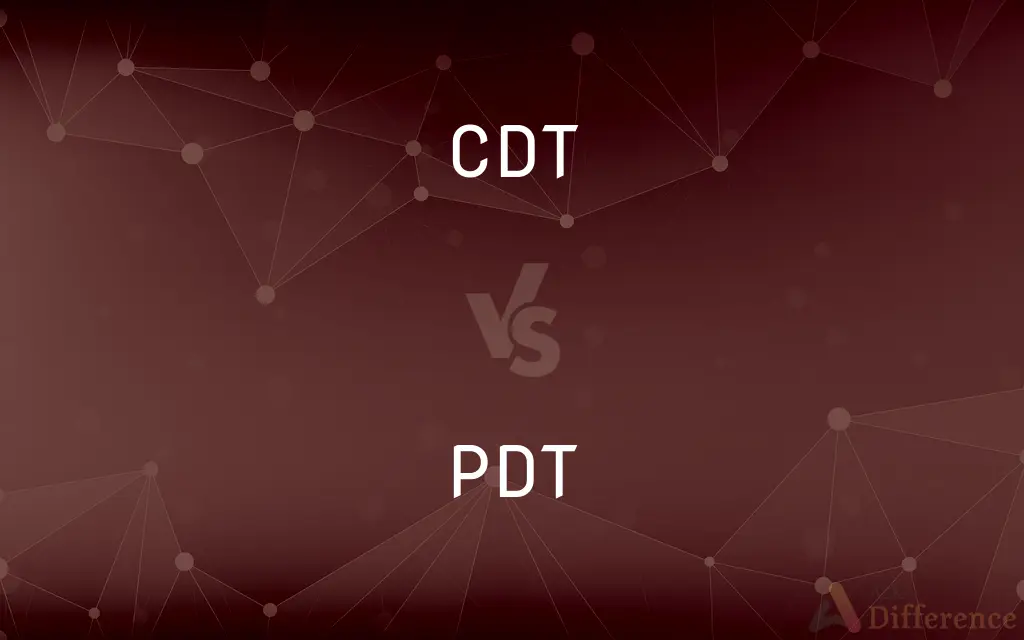CDT vs. PDT — What's the Difference?
By Tayyaba Rehman — Published on January 25, 2024
CDT (Central Daylight Time) is UTC-5, used in parts of North America, while PDT (Pacific Daylight Time) is UTC-7, used in the western part of North America.

Difference Between CDT and PDT
Table of Contents
ADVERTISEMENT
Key Differences
Central Daylight Time (CDT) and Pacific Daylight Time (PDT) are time zones observed in different regions of North America during Daylight Saving Time. CDT is observed in the Central Time Zone, while PDT is observed in the Pacific Time Zone.
CDT is UTC-5, meaning it is five hours behind Coordinated Universal Time (UTC). PDT is UTC-7, which puts it two hours behind CDT and seven hours behind UTC.
Areas observing CDT include parts of the United States, Canada, and Mexico. States like Texas, Illinois, and Missouri are examples. PDT is observed in states such as California, Washington, and Nevada.
Both CDT and PDT switch to standard time in the winter. CDT becomes CST (Central Standard Time, UTC-6), and PDT becomes PST (Pacific Standard Time, UTC-8).
Daylight Saving Time, which leads to the use of CDT and PDT, typically starts in March and ends in November, when clocks are adjusted one hour forward in the spring and one hour back in the fall.
ADVERTISEMENT
Comparison Chart
UTC Offset
UTC-5
UTC-7
Regions Covered
Central parts of North America
Western parts of North America
Example Locations
Texas, Illinois, Missouri
California, Washington, Nevada
Winter Time Change
Changes to CST (UTC-6)
Changes to PST (UTC-8)
Daylight Saving Period
March to November
March to November
Compare with Definitions
CDT
A time zone in North America, five hours behind UTC.
The meeting is scheduled for 10 AM CDT.
PDT
Observed in western parts of the US and Canada.
Los Angeles operates on PDT during the summer.
CDT
Changes to Central Standard Time in winter.
In November, we switch back from CDT to CST.
PDT
Changes to Pacific Standard Time in winter.
Seattle will revert to PST from PDT in the fall.
CDT
Affects states like Texas and Illinois.
Business hours in Texas are often listed in CDT.
PDT
Includes states like California and Washington.
Most businesses in California follow PDT in Daylight Saving Time.
CDT
Observed in central parts of the US, Canada, and Mexico.
Chicago observes CDT during the summer months.
PDT
A time zone in North America, seven hours behind UTC.
The webinar will start at 8 AM PDT.
CDT
Part of the Daylight Saving Time schedule.
We adjust our clocks for CDT in March.
PDT
Aligned with Daylight Saving Time practices.
Clocks are set forward for PDT in the spring.
Common Curiosities
What is the UTC offset for CDT?
The UTC offset for CDT is UTC-5.
What time zone follows CDT in winter?
In winter, CDT changes to Central Standard Time (CST), which is UTC-6
Which states in the US observe PDT?
States such as California, Washington, and Nevada observe PDT.
When do regions switch to PDT?
Regions switch to PDT with the start of Daylight Saving Time, usually in March.
Which states in the US observe CDT?
States like Texas, Illinois, and Missouri observe CDT.
What does PDT stand for?
PDT stands for Pacific Daylight Time.
What is the UTC offset for PDT?
The UTC offset for PDT is UTC-7.
What does CDT stand for?
CDT stands for Central Daylight Time.
How does Daylight Saving Time affect CDT and PDT?
Daylight Saving Time shifts clocks forward by one hour in spring and back by one hour in fall, affecting the time in CDT and PDT zones.
When do regions switch to CDT?
Regions switch to CDT during Daylight Saving Time, typically in March.
Can a state be in both CDT and PDT zones?
No, a state will either be in the CDT or PDT zone, but not both, as these zones are geographically distinct.
What time zone follows PDT in winter?
In winter, PDT changes to Pacific Standard Time (PST), which is UTC-8.
Are CDT and PDT observed all year round?
No, CDT and PDT are only observed during Daylight Saving Time, from March to November.
Is the time difference between CDT and PDT always two hours?
Yes, during Daylight Saving Time, the time difference between CDT and PDT is consistently two hours.
Do all states in the US observe Daylight Saving Time?
Not all states observe Daylight Saving Time; for example, Arizona and Hawaii do not.
Share Your Discovery

Previous Comparison
ISBN 10 vs. ISBN 13
Next Comparison
International Airport vs. Intercontinental AirportAuthor Spotlight
Written by
Tayyaba RehmanTayyaba Rehman is a distinguished writer, currently serving as a primary contributor to askdifference.com. As a researcher in semantics and etymology, Tayyaba's passion for the complexity of languages and their distinctions has found a perfect home on the platform. Tayyaba delves into the intricacies of language, distinguishing between commonly confused words and phrases, thereby providing clarity for readers worldwide.












































